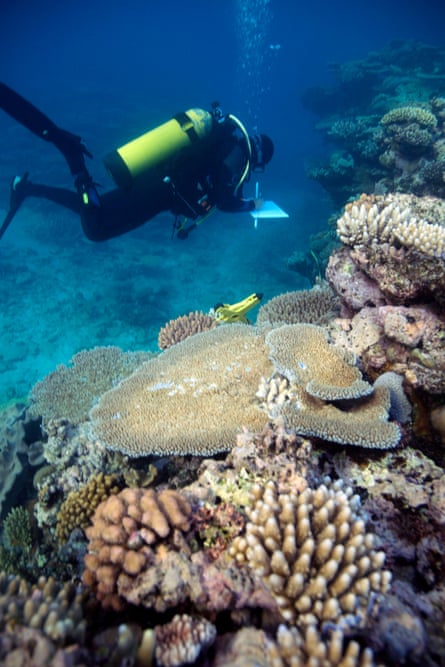Research into the Great Barrier Reef has discovered coral disease levels are four times lower inside no-take marine reserves – where fishing is banned – than outside reserves.
Scientists from James Cook University surveyed more than 80,000 corals around the Whitsunday Islands for six different diseases that commonly harm reefs around the world.
It is the first time a study has shown marine reserves enhance coral health on the Great Barrier Reef. The lead author, Joleah Lamb, said the finding had important implications for fish stocks across the reef and fishers whose activity had otherwise been restricted.
“Healthy coral inside reserves are vital habitats for reef fish,” she said. “And these reserve fish can spill outside of the reserves for fishers.”
Three coral diseases – skeletal eroding band, brown band, and a group of diseases called white syndromes – were found to be less prevalent inside no-take marine reserves, particularly compared with reefs with high levels of injured corals and discarded fishing line.
Lamb said some areas showed no coral disease, but on average the reserves had a 1% level of coral disease, “which is quite low”. On average disease levels outside the reserves were 5%, but in certain areas they went up to 9%.
Coral tissue damaged by discarded fishing line and other fishing-related activities is more vulnerable to disease. Exposed coral skeleton provides an entry point for pathogens to infect, leading to spreading tissue loss.

“It’s like getting gangrene on your foot and there is nothing you can do to stop it from affecting your leg and ultimately your whole body,” she said.
As well as injuring coral tissue, fishing lines also give potential pathogens another surface on which to colonise, said Lamb.
“Corals have way of fighting pathogens,” she said. “But if the pathogens are getting a one-up by having something to colonise on to, the coral are disadvantaged. And fishing line is generally made of very durable, long-lasting plastic so they stay in the environment for decades.”
Disease can wreak havoc on reef health. Lamb highlighted two major reef-building coral species in the Caribbean that have been classified as endangered after disease swept across the region and led to coral cover losses of up to 95%.
She said the fluid nature of the marine environment made isolating which pathogens were responsible for disease difficult.
In their study, three diseases did not show lower levels of prevalence on coral within reserves. These diseases are commonly associated with warm water temperature or increased sediment due to runoff, conditions which “can flow past [the] arbitrary boundaries” of marine reserves.
“So we need to be aware that we are unable to manage factors like dredging, climate change and agriculture, that could also be drivers of diseases, with marine reserves alone,” said Lamb.
Disease levels were significantly lower in the Great Barrier Reef marine park than in many other regions of the world, she said. “I think a lot of it is down to how much protection we have on the Great Barrier Reef and it shows how much we need to continue to protect it.”
A draft UN ruling in May recommended against listing the Great Barrier Reef as “in danger” but indicated the natural icon remains on its watch list.

Comments (…)
Sign in or create your Guardian account to join the discussion